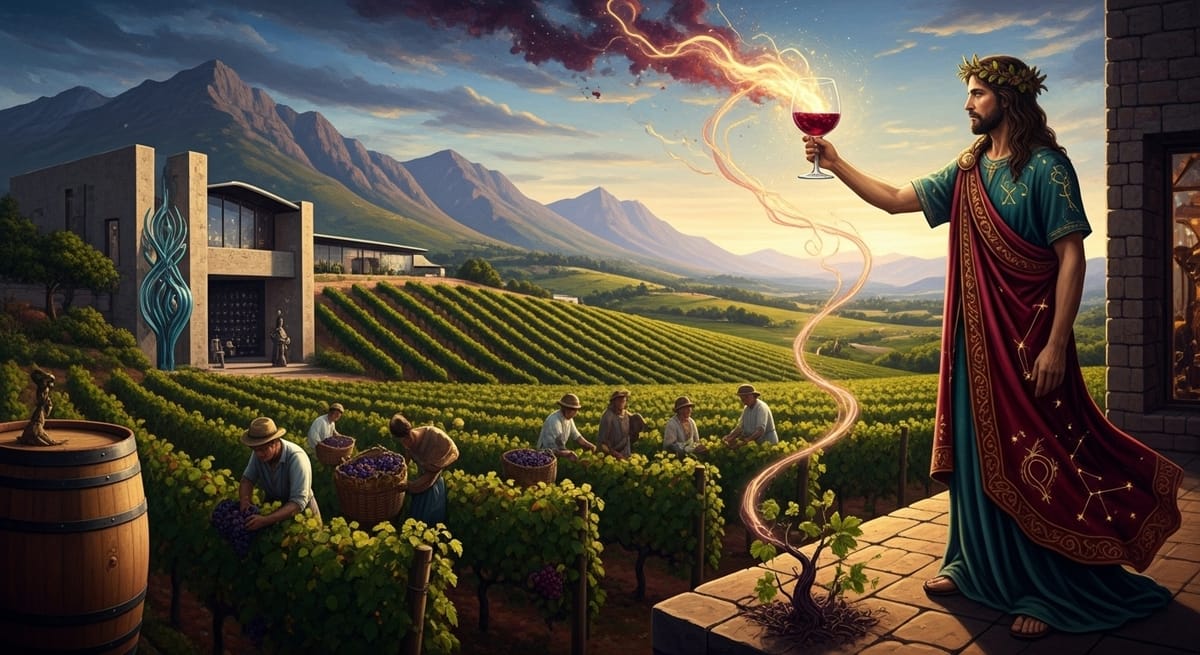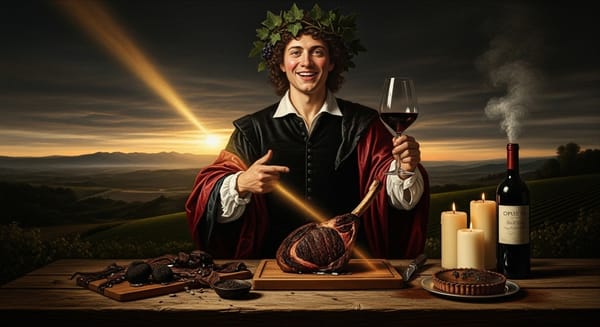The Bordeaux Duchess and the African Sun: The Story of Glenelly
Discover the story of Glenelly Estate — how Bordeaux legend May de Lencquesaing created a South African icon. Explore its rebirth on Stellenbosch’s slopes, where Old World precision meets New World vitality in wines built to last.

How a 250-year-old vision crossed continents, revived forgotten vineyards, and built a new South African icon from the soil up.
I. Prologue: Where Old Souls Find New Soil
There are moments in the story of wine when the gods themselves pause and smile. When the past and the future meet in a single vineyard row. When an old soul takes root in new earth and transforms it — not by force, but by faith.
Glenelly Estate, in the heart of Stellenbosch, is one of those rare places. It is a story of vision and audacity — but also of patience, reinvention, and destiny. And I, Liber, have watched it unfold with particular delight. For Glenelly is more than a winery. It is a bridge between centuries, continents, and civilizations — a living testament to the power of terroir and time.
II. Before Glenelly: The Duchess and the Dream
Our story begins not in South Africa, but in Bordeaux, amid the limestone cellars and grand châteaux of France’s Left Bank. There, a formidable woman named May de Lencquesaing — the “Grande Dame” of Château Pichon Longueville Comtesse de Lalande — built a global reputation as one of Bordeaux’s most respected vintners.
For decades, she stewarded Pichon Lalande with vision and grace, guiding it to international acclaim. But by the late 1990s, as the new millennium approached, May found herself restless. Bordeaux was thriving — but her gaze turned southward, to a place where the potential was untapped and the future unwritten.
“I wanted to plant the flag of Bordeaux where the sun shines brighter,” she would later say. And so, in 2003, at the age of 78, May de Lencquesaing did what few would dare: she sold Pichon Lalande and sailed for the southern hemisphere, determined to start again.
III. The Birth of Glenelly: A Vineyard Reborn
The land she chose lay on the Simonsberg slopes of Stellenbosch, South Africa’s most prestigious wine region. The site had history — vines had been planted there since the 17th century, during the earliest days of the Cape’s viticultural era — but by the 21st, much of its potential lay dormant.
May saw more than land. She saw possibility: decomposed granite soils perfect for Cabernet Sauvignon, Syrah, and Merlot, cooling breezes from False Bay, and a Mediterranean climate capable of producing wines of power and poise. She named the estate Glenelly — a Gaelic name meaning valley of light — and vowed to create a world-class winery from the ground up.
The transformation was total. May and her team replanted vineyards, revitalized soils, and built a cutting-edge gravity-flow cellar carved into the hillside. They embraced sustainable farming, precision viticulture, and a philosophy that fused Old World structure with New World generosity. It was a bold vision — Bordeaux heritage reborn beneath the African sun.
IV. The Signature: Elegance, Structure, and Light
From its very first vintages, Glenelly’s wines spoke with a clear, confident voice — one that echoed May’s deep understanding of Bordeaux yet sang in the unique accent of South African terroir.
- Lady May, the flagship Cabernet Sauvignon, quickly became a benchmark for Stellenbosch: concentrated but graceful, with graphite, cassis, tobacco, and fine, sinewy tannins — a wine built for decades in the cellar.
- The Estate Reserve red blend showed a seamless fusion of Cabernet, Merlot, Syrah, and Petit Verdot — a modern classic defined by balance and depth.
- Even the Glass Collection, Glenelly’s accessible range, displayed remarkable precision and personality — proof that May’s vision extended from the grandest cuvée to the humblest bottle.
What set Glenelly apart was not power but structure — wines with the skeleton of Bordeaux but the soul of Stellenbosch. They were generous but restrained, polished but alive. And they carried the unmistakable imprint of the land: granite minerality, sunlight ripeness, and an undercurrent of African spice.
V. A Legacy Beyond Wine
But Glenelly was always meant to be more than a winery. For May de Lencquesaing, it was a cultural project — a bridge between continents and a dialogue between traditions. On the estate grounds, she built the Glenelly Glass Museum, one of the most significant private glass art collections in the world, spanning centuries and civilizations. It is a symbol of her belief that wine, like art, is an expression of beauty, heritage, and humanity.
Today, Glenelly stands as one of the most acclaimed estates in the New South Africa, earning international recognition while staying true to May’s original ethos: “To make wines of elegance and longevity — wines that will outlive me.”
VI. Liber’s Reflection: The Valley of Light
I, Liber, have seen many vineyards born of ambition — but few born of such conviction. May de Lencquesaing did not come to South Africa seeking glory or wealth. She came to plant a seed. And like the vines she nurtured, that seed has taken root and flourished beyond expectation.
Glenelly is not a mimicry of Bordeaux, nor a rejection of it. It is a conversation — between Old World and New, between tradition and innovation, between the wisdom of age and the energy of reinvention. It is proof that wine, like humanity, thrives when it crosses borders and embraces change.
When I walk through Glenelly’s sun-drenched vineyards, I feel the weight of centuries and the lightness of new beginnings. And when I raise a glass of Lady May, I taste both — the deep, steady heartbeat of Bordeaux and the bright, joyful pulse of Africa.
🌞 Final Benediction
Some estates are born.
Some are reborn.
Glenelly was reimagined — a testament to courage, curiosity, and the timeless truth that great wine knows no borders.





